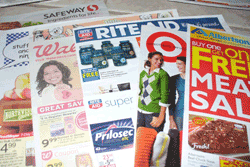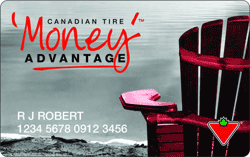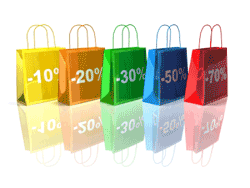Old-school advertising, such as circulars, coupons and newspaper ads eat up a huge percentage of the marketing budget. They’re hard to give up on, however, because they drive serious traffic. The way around this old vs. new school marketing, however, is through customer insight.
 The Stanford Graduate School of Business concluded in a 2006 study that at least 10% of shoppers make store choices based on weekly circulars, particularly ads for cereal, chips, pizza, cookies and hot dogs. The study also identified several challenges with studying mass advertising—including the inability to measure individual customer response tied to specific offers.
The Stanford Graduate School of Business concluded in a 2006 study that at least 10% of shoppers make store choices based on weekly circulars, particularly ads for cereal, chips, pizza, cookies and hot dogs. The study also identified several challenges with studying mass advertising—including the inability to measure individual customer response tied to specific offers.
With improvements in technology, however, marketers are now able to conduct their own studies—without enlisting the aid of graduate schools—and can now examine their customer data more closely and push to apply their loyalty-program analytic standards to mass advertising.
The burn of old-school advertising
Whether a result of the continuing economic pinch or just the ageless thrill of getting a bargain, customers still love coupons and discounts. In 2011, U.S. consumers redeemed 3.5 billion coupons from consumer packaged goods companies, a 6.1% increase over 2010, according to a study from NCH Research. This was especially true for mass merchandisers, with a coupon redemption increase of 16.7%; and drug stores with redemption rates that rose a staggering 37.6%.
No wonder retailers keep spending on circulars and coupons. But for classic high-frequency retailers like grocers, this expense can eat up 50% of the promotional budget and up to 20% of the marketing budget. So the priority has to be to ensure that discounts incorporate insights from customer data so that they don't merely pull in traffic, but rather pull in the right traffic.
Dorothy Lane Market eliminates the cherry pickers
Ohio-based gourmet grocery chain Dorothy Lane Market boldly stopped printing traditional circulars in 1995. Tom Winter, vice president of marketing at the chain, said that with those circulars, “All we did was attract the cherry-pickers.” DLM founder Norman Mayne said at the time that dropping the circulars meant that the company “fired” an entire segment of customers—they just stopped coming into the store.
But when DLM gave up its circulars, it diverted those resources to its loyalty program, Club DLM. It swapped discounts for smart discounts, emailing the circular to everyone in its email database and sending additional targeted discounts to the top 30% of its customers (those spending $20 per week or more who account for over 80% of sales).
By focusing on high-value customers, DLM increased gross margins by 2%.
“Now our main focus is maintaining our existing customers rather than targeting new ones,” Winter said. DLM does see about 250 new households in the company's three stores every week, which the company attributes to word-of-mouth and targeted marketing sent to people who have purchased a new home near one of the stores.
The traditional thinking is that a loss leader will pull in a price shopper who then adds a few more (profitable) items to the basket. But the truth is that bargain-seekers are the least likely to do that, according a 2012 study from Point of Purchase Advertising International. The study broke shoppers into four segments: Explorers, Time Stressed, Bargain Hunters and Trip Planners. Bargain Hunters, who accounted for 22% of the shoppers, had the lowest total basket average at $54. They were also the least likely to make impulse purchases in-store (in-store marketing is ranked as one of the most-important channels for customer engagement by consumer goods marketers and grocers).
Technology fires up new options
Technology powers both in-house insight and trendy new customer engagement channels. Two mass merchandisers have recently recognized technology's firepower and are taking steps to harness it.
Lowe's rolled out the My Lowe's program in 2011 to begin gathering customer data. My Lowe's membership doesn't offer discounts, but instead gives customers online perks like purchase tracking (storing paint colors, for example) digital receipt storage and a reminder calendar to track household projects. The company emails digital circulars to program members weekly.
 Canadian Tire is one of Canada's most-shopped general retailers and the country's largest sporting goods retailer. It has long offered Canadian Tire paper ‘Money.' In February 2012, they began piloting Canadian Tire ‘Money' Advantage in Nova Scotia—an electronic membership card with digital currency, which has exceeded expectations.
Canadian Tire is one of Canada's most-shopped general retailers and the country's largest sporting goods retailer. It has long offered Canadian Tire paper ‘Money.' In February 2012, they began piloting Canadian Tire ‘Money' Advantage in Nova Scotia—an electronic membership card with digital currency, which has exceeded expectations.
“With paper by itself, we couldn't gather customer-specific data,” said Allan MacDonald, senior vice president of marketing. “We have our own credit card; so, for those purchases we could get some data, but it was limited. Customers don't use that credit card all the time; so, you miss transactions for that particular customer.”
The company invested in an enterprise-wide technology system to support the Money Advantage program and implemented it across Canadian Tire retail and Gas + locations.
“Data is a strategic asset,” MacDonald said. “We want to know, for example, what our customer foot traffic looks like, whether our pricing should be premium-based, what assortment we should have. A little bit of data will spark a tremendous amount of strategic opportunity for us.”
The program is still in its early stages, and MacDonald said that customer participation levels have exceeded expectations.
“Now that we're starting to get some traction, we're coming into an important shopping season and are starting to see basket and frequency information,” he said. “The typical loyalty metrics are starting to populate.”
Armed with that data, Canadian Tire plans to test one-to-one marketing campaigns, cross-category promotions and offers designed to drive basket lift.
Canadian Tire is leveraging technology both ways—as an internal asset and as a customer-engagement tool. Consumers in general are quickly adopting such digital options as e-coupons, real-time redemption offers, location-based offers and QR codes. Retailers who can incorporate these trends into their marketing efforts earn increased customer engagement.
As further evidence, members of Safeway's “just for u” program can go all digital if they like. Safeway offers digital coupons on hundreds of items, but rather than forcing customers to wade through all of those in search of the right offer, Safeway provides two options: The first allows members to search by brand name, such as “Pampers.” The second allows customers to list all coupons in order of relevance, based on purchase history. They can download the coupons, which are then automatically redeemed when they swipe their “just for u” card. This structure presents a huge time-saver and added value to Safeway's priority customers.
The program's software also automatically compares items with Walmart and Target prices and shares that comparison with the customer when Safeway's price is lower.
Unfortunately, the technology-use boom among customers doesn't always help retailers. For example, the list of often free third-party coupon and discount app programs that compare prices and highlight the lowest ones within the customer's geographic area or online favorites is long. Apps like Grocery Pal and Coupon Sherpa track discounts on groceries, clothing, toys and other consumer goods.
Industry experts say the easy price comparisons encourage cherry pickers instead of reinforcing a store's value proposition and shoring up loyalty shoppers. In the past, companies could take advantage of a consumer's “search cost” to offer value to time-pressed customers who didn't want to invest in comparison shopping. Now that technology is eliminating those search costs, cherry pickers are a growing segment.
Customers are demanding more technology options directly from retailers, who are unfortunately letting them down. Although 83% of the nation's top 100 retailers offer a mobile app, according to IT consulting firm Cognizant, those apps get low ratings. Over half (54%) of iPhone apps merited two or fewer stars on a five-star scale, while 22% of Android apps rated that low. Even if your customers aren't clamoring for more technology today, they will be tomorrow—now is the time to experiment with social and mobile technology. Last year, only 37% of consumers said they had never shopped using their mobile device, compared to nearly 60% in 2010, according to a 2012 survey from eDigital Research. In 2012, 20% of those surveyed reported using their devices to shop monthly, compared to only 13% two years ago.
Identifying loss leaders
Traffic is the payoff for featuring a loss leader, and retailers have long known how to balance the returns for that tradeoff. Here's what's changing—retailers usually know your best loss leaders on price margins, but now many are also identifying their loss leaders based on high-value customers. And they're learning how to optimize marketing, merchandising, price and assortment depending on what those customers want and are willing to pay. In fact, these retailers may discover that their reliable “loss leaders” can actually be priced to be profitable—call them “gain leaders” perhaps.
 For example, a retailer may feature girls' jeans at a heavy discount to drive traffic—40% off. Customer data indicates that the store's priority customers may be willing to pay a higher price for that item. Offering the jeans at 40% off may move 130 pairs, but when the retailer tests 20% off, it sells 100 units—leading to more income and stronger ROI on fewer sales.
For example, a retailer may feature girls' jeans at a heavy discount to drive traffic—40% off. Customer data indicates that the store's priority customers may be willing to pay a higher price for that item. Offering the jeans at 40% off may move 130 pairs, but when the retailer tests 20% off, it sells 100 units—leading to more income and stronger ROI on fewer sales.
The truth is that most retailers, especially those with an existing loyalty program, already know who their customers are and what they are buying. High-frequency retailers have the advantage of transacting with customers several times a month. They can tweak offers and see immediate response, growing a relationship of ongoing communications between retailer and customer.
Charles Duhigg's book The Power of Habit, and an article in The New York Times, both outed Target for its customer-insight-driven merchandising efforts. Target's command of customer data is impressive and widely used throughout the organization. Target identified expectant mothers as a high-potential segment; built predictive models to inform their product mix for those customers; and, mailed coupons to their expectant mothers at just the right points in their pregnancies.
Interestingly, Target chose to add a few generic coupons to each mailer so that it wouldn't appear quite so well targeted. Target's efforts paid off with a 65% growth in revenue from 2002 to 2010.
Building the fire
At the moment, grocers, mass merchandisers and pharmacies are each at different stages of burning up their traditional mass-advertising channels. Grocers have the biggest data warehouses, but many are still afraid to tweak the beloved circular by moving items around or changing ad frequency. Pharmacies like Rite Aid, CVS and Walgreens are further along with actual experimentation, but are still early in this customer-focused process when compared to retailers in industries like specialty retail, hospitality or financial services. Mass merchandisers like Lowe's and Canadian Tire are just getting started. Clearly, now is a promising moment to light a fire under your own mass advertising strategies.
To take advantage of these new behind-the-scenes strategies, we advise lighting up your traditional advertising in these three arenas:
- Marketing: What products do your high-value, high-potential customers want? How do they want to receive those offers? Use customer insights to inform your decisions about what products to feature and how to promote them.
- Pricing:What products are your high-value, high-potential customers price-sensitive to? Those products, at the right prices, belong on the circular cover or in the coupon mailer. Safeway is a prime example of mastering customer-centric pricing so that it can undercut its competitors in key categories.
- Promotion:What product mix will bring in the right customer? Are your ads attracting cherry pickers, or high-value shoppers who add profitable items to their baskets? Customer insights can drive decision-making on which key products to feature, where to feature them, and how often.
With coupon redemption on the rise, and circulars driving traffic, customers are definitely still receptive to traditional advertising methods. But in today's economic climate, retailers can't afford to eat into profits by featuring widespread loss leaders or attracting more cherry-picking shoppers. Instead, it's time to drive the right traffic and use traditional advertising to heat up your priority customer base.
Phaedra Hise is senior editor of Colloquy. She can be reached at phaedra.hise@colloquy.com



